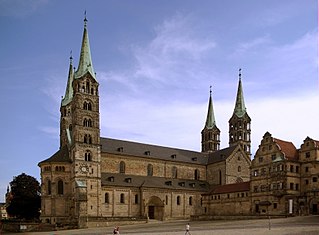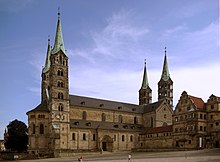
Bamberg is a town in Upper Franconia district in Bavaria, Germany, on the river Regnitz close to its confluence with the river Main. Bamberg had 79,000 inhabitants in 2022. The town dates back to the 9th century, when its name was derived from the nearby Babenberch castle. Cited as one of Germany's most beautiful towns, with medieval streets and buildings, the old town of Bamberg with around 2,400 timber houses has been a UNESCO World Heritage Site since 1993.

Franconia is a region of Germany, characterised by its culture and East Franconian dialect. Franconia is made up of the three Regierungsbezirke of Lower, Middle and Upper Franconia in Bavaria, the adjacent, Franconian-speaking South Thuringia, south of the Thuringian Forest—which constitutes the language boundary between Franconian and Thuringian—and the eastern parts of Heilbronn-Franconia in Baden-Württemberg.

The Prince-Archbishopric of Salzburg was an ecclesiastical principality and state of the Holy Roman Empire. It comprised the secular territory ruled by the archbishops of Salzburg, as distinguished from the much larger Catholic diocese founded in 739 by Saint Boniface in the German stem duchy of Bavaria. The capital of the archbishopric was Salzburg, the former Roman city of Iuvavum.

The Duchy of Bavaria was a frontier region in the southeastern part of the Merovingian kingdom from the sixth through the eighth century. It was settled by Bavarian tribes and ruled by dukes (duces) under Frankish overlordship. A new duchy was created from this area during the decline of the Carolingian Empire in the late ninth century. It became one of the stem duchies of the East Frankish realm, which evolved as the Kingdom of Germany and the Holy Roman Empire.

The Prince-Bishopric of Würzburg was an ecclesiastical principality of the Holy Roman Empire located in Lower Franconia, west of the Prince-Bishopric of Bamberg. Würzburg had been a diocese since 743. As established by the Concordat of 1448, bishops in Germany were chosen by the canons of the cathedral chapter and their election was later confirmed by the pope. Following a common practice in Germany, the prince-bishops of Würzburg were frequently elected to other ecclesiastical principalities as well. The last few prince-bishops resided at the Würzburg Residence, which is one of the grandest Baroque palaces in Europe.

The House of Schönborn is the name of an ancient noble and formerly sovereign family of the Holy Roman Empire. As a former ruling and mediatized family, it belongs to the Hochadel.

German mediatisation was the major redistribution and reshaping of territorial holdings that took place between 1802 and 1814 in Germany by means of the subsumption and secularisation of a large number of Imperial Estates, prefiguring, precipitating, and continuing after the dissolution of the Holy Roman Empire. Most ecclesiastical principalities, free imperial cities, secular principalities, and other minor self-ruling entities of the Holy Roman Empire lost their independent status and were absorbed by the remaining states. By the end of the mediatisation process, the number of German states had been reduced from almost 300 to 39.

The Metropolitan Archdiocese of Bamberg is a Latin Church diocese of the Catholic Church in Bavaria, one of 27 in Germany. In 2015, 32.9% of the population identified as Catholic, and 15.6% of those reported that they attend Mass on Sunday—a relatively high number in Germany. The archdiocese comprises the majority of the administrative regions of Upper Franconia and Middle Franconia, as well as a small part of Lower Franconia and the Upper Palatinate. Its seat is Bamberg. The dioceses of Speyer, Eichstätt, and Würzburg are subordinate to it. The diocese was founded in 1007 out of parts of the dioceses of Eichstätt and Würzburg. In 1817, the diocese was raised to an archdiocese.

The Franconian Circle was an Imperial Circle established in 1500 in the centre of the Holy Roman Empire. It comprised the eastern part of the former Franconian stem duchy—roughly corresponding with the present-day Bavarian Regierungsbezirke of Upper, Middle and Lower Franconia—while western Rhenish Franconia belonged to the Upper Rhenish Circle. The title of a "Duke of Franconia" was claimed by the Würzburg bishops.

Bamberg Cathedral is a church in Bamberg, Germany, completed in the 13th century. The cathedral is under the administration of the Archdiocese of Bamberg and is the seat of its archbishop. Since 1993, the cathedral has been part of the UNESCO World Heritage Site "Town of Bamberg".

The Duchy of Franconia was one of the five stem duchies of East Francia and the medieval Kingdom of Germany emerging in the early 10th century. The word Franconia, first used in a Latin charter of 1053, was applied like the words Francia, France, and Franken, to a portion of the land occupied by the Franks.

Hallstadt is a town in the Upper Franconian district of Bamberg on the left bank of the Main, 4 km north of Bamberg.
Imperial cathedral is the designation for a cathedral linked to the Imperial rule of the Holy Roman Empire.

The Prince-Bishopric of Augsburg was one of the prince-bishoprics of the Holy Roman Empire, and belonged to the Swabian Circle. It should not be confused with the larger diocese of Augsburg, over which the prince-bishop exercised only spiritual authority.

The Bamberg witch trials of 1627–1632, which took place in the self-governing Catholic Prince-Bishopric of Bamberg in the Holy Roman Empire in present-day Germany, is one of the biggest mass trials and mass executions ever seen in Europe, and one of the biggest witch trials in history.

Christoph Franz von Buseck was the Roman Catholic bishop of Bamberg and the last Prince-Bishop of Bamberg.

Henry II, also known as Saint Henry, Obl. S. B., was Holy Roman Emperor from 1014. He died without an heir in 1024, and was the last ruler of the Ottonian line. As Duke of Bavaria, appointed in 995, Henry became King of the Romans following the sudden death of his second cousin, Emperor Otto III in 1002, was made King of Italy in 1004, and crowned emperor by Pope Benedict VIII in 1014.

The Bamberg State Library is a combined universal, regional and research library with priority given to the humanities. Today it is housed in the New Residence, the former prince-bishop's new palace. The Free State of Bavaria is responsible for the library.

Franconia is a region that is not precisely defined, but which lies in the north of the Free State of Bavaria, parts of Baden-Württemberg and South Thuringia and Hesse in Germany. It is characterised by its own cultural and linguistic heritage. Its history began with the first recorded human settlement about 600,000 years ago. Thuringii, Alemanni and Franks, who gave the region its name, settled the area in the Early Middle Ages. From the mid-9th century, the Stem Duchy of Franconia emerged as one of the five stem duchies of the Empire of East Francia. On 2 July 1500, during the reign of Emperor Maximilian I, as part of the Imperial Reform, the empire was divided into Imperial Circles. The Franconian Circle, which was formed as a result of this restructuring, became decisive in the creation of a Franconian national identity. A feature of Franconia in the Middle Ages and Early Modern Period was its Kleinstaaterei, an extreme fragmentation into little states and territories. In the 19th century under Napoleon, large parts of Franconia were incorporated into the newly created Kingdom of Bavaria.

Rosenberg Fortress is a fortress situated on a hill overlooking Kronach, a town in the Upper Franconia region of Bavaria, Germany. It is one of the largest, best-preserved, and most complete fortresses in Bavaria. Tracing its origins back to the 13th century, the fortress was never captured by violent means. Originating as a medieval hill castle, it was transformed into a massive baroque fortress complex during the early modern period, being one of the two fortresses of the Prince-Bishopric of Bamberg. With countless construction stages representing centuries of architectural development visible, Rosenberg Fortress serves as an outstanding example of the evolution of defensive architecture in Germany. Including its moats and ravelins, the fortress covers an area of circa 8.5 hectares.

























